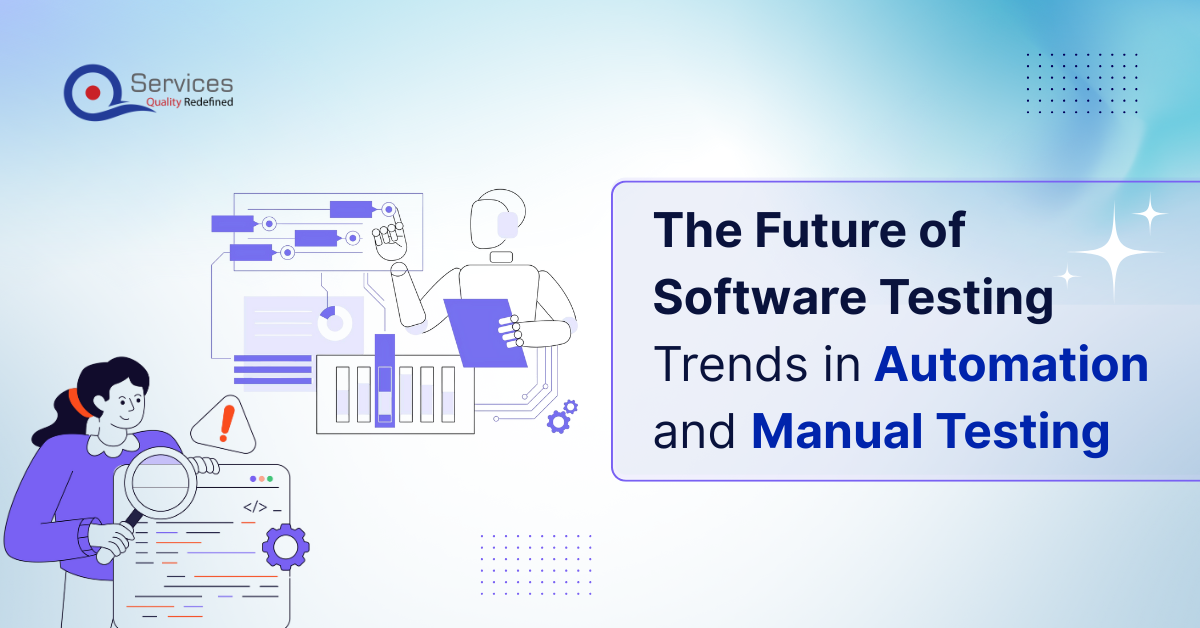
Home » The Future of Software Testing: Trends in Automation and Manual Testing

Software testing is a vital part of software development. It guarantees that software functions properly, is bug-free, and provides a seamless user experience. As new technology and trends emerge, testing methods are evolving.
Increased Automation in Testing – Organizations are embracing automation for repetitive tests to enhance efficiency and reduce time spent.
AI & Machine Learning in Testing – The integration of AI accelerates bug detection and boosts the precision of tests.
Scriptless Automation – New tools enable testers to automate processes without needing to write code, making it accessible for those without programming skills.
Cloud-Based Testing – Utilizing cloud technology allows teams to collaborate remotely and easily test across various devices.
Continuous Testing in DevOps – Testing is integrated at every phase of software development to maintain high quality.
Emphasis on Security & Performance Testing Automation – There is a growing focus on automating security and performance testing to ensure applications are both secure and efficient.
Exploratory Testing – Testers leverage their creativity to uncover unforeseen problems that automation might overlook.
Usability & UX Testing – Making sure applications are intuitive and deliver a seamless user experience.
AI-Assisted Manual Testing – Artificial intelligence aids manual testers in identifying issues more efficiently.
Testing in Agile & DevOps – Manual testing complements automation within rapid development cycles.
Increased Focus on Human Skills – Testers enhance their problem-solving abilities, critical thinking, and expertise in specific domains.
Thus, the fields of manual and automated testing are both evolving, with AI-powered testing taking the lead. Automation is helping to minimize repetitive tasks, but manual testing is still essential for ensuring a great user experience and addressing edge cases.
Automating software testing is an excellent method to boost efficiency, minimize human mistakes, and guarantee consistent quality in software development. Here are some of the practices for successfully implementing and sustaining a robust software testing automation strategy.
1. Select the Right Test Cases for Automation – Focus on automating tests that are repetitive and take a lot of time. Target stable features that are used often, and steer clear of tests that change frequently.
2. Choose the Appropriate Automation Tools – Select a tool that fits your application needs (like Selenium for web applications or Appium for mobile). Look for tools that work well with your existing technology.
3. Establish a Clear Testing Strategy – Decide which tests to automate and when to run them (for example, daily or after code updates). Plan how to manage test data and set up the testing environment.
4. Create Clean and Reusable Test Scripts – Use clear names for your test cases and variables. Stick to coding best practices to ensure your tests are easy to read and maintain. Reuse functions to minimize duplicate code.
5. Implement Data Driven Testing – Keep your test data separate (like in Excel, JSON, or a database). This allows you to run the same test with various data sets, saving time.
6. Ensure Tests are Fast and Reliable – Avoid unnecessary delays by using smart waits (like implicit or explicit waits). Only run the essential tests to keep the execution time short.
7. Integrate Tests in Continuous Integration (CI/CD) – Connect your automated tests with CI/CD tools (such as Jenkins or GitHub Actions). This way, tests run automatically whenever new code is added.
8. Address Flaky Tests – Quickly investigate and resolve any unstable tests. Implement proper error handling and logging to monitor failures.
9. Regularly Update and Maintain Test Scripts – Adjust tests when there are changes in the application. Remove outdated tests and add new ones as necessary.
10. Review Test Reports and Logs – Examine reports to understand any failures. Use logging to quickly identify and resolve issues.
By following to these best practices will help a user to create a strong, scalable, and efficient automation framework that improves software quality.
Get free Consultation and let us know your project idea to turn into an amazing digital product.

The future of software testing automation is quite bright as technology continues to evolve which will make testing faster, easier, and more dependable.
Increased Use of AI & Machine Learning (ML) – Testing tools are becoming smarter and quicker, automatically identifying problems and enhancing test cases with minimal human input.
Reduced Manual Effort – More processes will be automated, leading to less reliance on manual testing. This will save time and allow testers to concentrate on more important tasks.
Quicker Testing – Testing will begin earlier in the development cycle, which will help identify bugs sooner and enhance software quality.
Cloud Testing – More testing will be conducted online (in the cloud), making it easier to test across various devices and operating systems.
Improved Test Automation Tools – New tools will be user-friendly and support various programming languages, making automation more accessible to everyone.
Increased Focus on Security Testing – With the rise in cyber threats, automation will play a crucial role in quickly identifying security vulnerabilities before they can be exploited.
Codeless Automation – Future tools will enable testers to create tests without needing to code, simplifying automation for those who aren’t programmers.
Enhancing the efficiency of manual testing focuses on maximizing time, effort, and resources, all while preserving or even boosting the quality of the testing process. Here are some practical strategies you can implement:
Plan Effectively – Before you begin testing, create a checklist of items to verify. Start with the most critical features that users value the most. This helps you avoid spending time on less significant aspects.
Utilize Test Cases – Develop straightforward, reusable test cases outlining what to check and how to do it. This approach saves time by eliminating the need to start from scratch each time.
Prioritize Issues – Not all problems require immediate attention. Concentrate on resolving major issues (like system crashes) before addressing minor ones (like a small typo). This approach keeps the testing process efficient.
Distribute Tasks Wisely – If you’re working in a team, assign tasks based on individual strengths. For instance, one person can handle the login functionality while another focuses on the payment process. This minimizes overlap and increases efficiency.
Document Findings – Keep a record of your discoveries—bugs, procedures, and screenshots—as you test. This is much quicker than trying to recall everything later.
Leverage Tools – Use simple tools such as checklists, bug tracking software (like Jira), or spreadsheets to organize your tasks and enhance efficiency.
Start Testing Early – Begin testing as soon as a feature is ready, rather than waiting until the end. Identifying issues early on reduces the need for extensive rework later.
Reflect and Improve – After each testing session, evaluate what hindered your progress and make adjustments for next time—whether it’s unclear instructions or missing information.
Therefore, by staying organized, focused, and straightforward helps a user test more quickly.
Automation testing tools streamline the process of software testing by eliminating the need for manual intervention each time. These tools execute tests, identify bugs, and verify that the software functions correctly. Here are some well-known options:
1. Selenium – Ideal for web applications, compatible with various browsers like Chrome and Firefox.
2. Appium – Perfect for mobile applications on both Android and iOS platforms.
3. JUnit & TestNG – Primarily designed for testing Java applications.
4. Cypress – A quick and user-friendly tool for web application testing.
5. Postman – Utilized for testing APIs and backend services.
6. JMeter – Assesses software performance under heavy load conditions.
7. Katalon Studio – An accessible tool for testing web, mobile, and API applications.
8. Playwright – A contemporary tool for testing web applications across multiple browsers.
9. Robot Framework – Suitable for both web and mobile automation with straightforward scripting.
10. Ranorex – Great for beginners, supporting desktop, web, and mobile applications.
Share your project idea with us. Together, we’ll transform your vision into an exceptional digital product!

Manual testing in Agile offers numerous advantages, particularly because agile teams operate in short cycles (sprints) and require rapid feedback. Here are some key benefits:
Enhanced Flexibility – Agile projects often undergo changes, and manual testing enables testers to swiftly adjust to new requirements.
Instant Feedback – Testers can provide immediate insights to developers, facilitating quicker resolution of issues.
Exploratory Testing – Manual testing allows testers to discover unforeseen problems by exploring the software beyond predefined test cases.
User Experience Evaluation – People can better assess the aesthetics, functionality, and usability of an application compared to automated tools.
Cost-Effective for Minor Adjustments – Rather than investing time in automating small changes, manual testing can quickly confirm them.
Quicker in Initial Phases – While automation requires time to set up, manual testing can commence right away, ensuring early detection of issues.
Assists with Complex Scenarios – Certain test cases, such as visual assessments, usability checks, or ad-hoc testing, are often more effective when performed manually.
Rapid Adaptation to New Features – Agile teams regularly roll out updates, and manual testing provides immediate validation of new functionalities.
Ideal for Exploratory & Ad-hoc Testing – Agile promotes ongoing learning, allowing testers to investigate the application without strict test cases and uncover hidden bugs.
Collaboration & Teamwork – Manual testers collaborate closely with developers, designers, and product owners, enhancing communication and understanding of the product.
The future of software testing is evolving into a mix of automation and manual techniques, both adapting to the needs of modern software development. Automation testing is making significant move with the incorporation of AI, machine learning, and codeless solutions, which facilitate quicker, more efficient, and smarter testing methods. It shines in managing repetitive tasks, boosting security, and enabling continuous testing within DevOps and Agile environments.
On the other hand, manual testing remains crucial due to its human-centric advantages such as exploratory testing, usability assessments, and flexibility in navigating complex or shifting scenarios ensuring a smooth user experience that automation alone may not achieve.
As technology advances, the collaboration between these two methodologies will shape the future of software testing. Automation will keep minimizing manual workloads and speeding up development timelines, while manual testing will maintain the essential role of human intuition and creativity.
By adopting best practices, choosing the right tools, and encouraging teamwork, teams can find the perfect balance to produce high-quality, dependable, and user-friendly software. The future is about embracing both automation and manual testing as complementary elements, adapting to new trends, and concentrating on what truly matters: creating software that functions effectively and delights its users.
Manual testing is performed by humans exploring the software, while automated testing uses scripts and tools to execute predefined test cases automatically.
Use automation for repetitive tasks, regression testing, and performance testing. Manual testing is better for exploratory testing and user experience evaluation.
You need analytical thinking, attention to detail, communication skills, basic technical knowledge, and understanding of testing methodologies.
Costs vary based on tools chosen, project complexity, and team expertise. Initial investment is higher but offers long-term cost savings.
Automate test cases that are repetitive, time-consuming, prone to human error, and involve testing stable features across multiple environments.
Manual testing in agile provides quick feedback, adapts to changing requirements, and focuses on exploratory testing during short development cycles.
Regression testing verifies that recent code changes haven’t broken existing functionality, ensuring overall application stability after updates or fixes.
Black box testing examines functionality without looking at internal code, while white box testing examines the internal structure and code of the application.
Smoke testing verifies that critical functionalities work before deeper testing. Sanity testing checks specific functionality after bug fixes without extensive testing.
Non-programmers can use codeless automation tools like Katalon Studio, TestComplete, or record-and-playback features in tools like Selenium IDE.

Software development thrives on efficiency, and automated testing seems like the golden ticket. It’s designed to save time, catch bugs early, and free up testers for more creative work. But here’s the reality: the path to effective automation is riddled with pitfalls.

In today’s fast-paced software development landscape, delivering high-quality applications quickly is a non-negotiable priority. However, achieving this balance between speed and quality often feels like chasing two rabbits at once. Enter the hybrid testing strategy—a powerful approach that combines the strengths of manual and automated testing to optimize results.

React Native has revolutionized mobile app development by allowing developers to build cross-platform applications with a single codebase.
INDIA : F-190, Phase 8B, Industrial Area, Sector 74,
Mohali, India
CANADA : 55 Village Center Place, Suite 307 Bldg 4287, Mississauga ON L4Z 1V9, Canada
USA :2598 E Sunrise Blvd, Fort Lauderdale,FL 33304,
United States

Founder and CEO

Chief Sales Officer
